Wireshark Lab Solution: DHCP
�
DHCP messages are sent over UDP (User Datagram Protocol).
Frame 2 (342 bytes on wire, 342 bytes captured)
Ethernet II, Src: 192.168.243.92 (00:90:4b:69:dd:34), Dst: Broadcast (ff:ff:ff:ff:ff:ff)
Internet Protocol, Src: 0.0.0.0 (0.0.0.0), Dst: 255.255.255.255 (255.255.255.255)
User Datagram Protocol, Src Port: bootpc (68), Dst Port: bootps (67)
Source port: bootpc (68)
Destination port: bootps (67)
Length: 308
Checksum: 0xd1a1 [correct]
Bootstrap Protocol
1.
2.
3.
The port numbers are the same as the example in the Lab.
The Link Layer address of my workstation is: 00:90:4b:69:dd:34
Frame 1 (342 bytes on wire, 342 bytes captured)
Ethernet II, Src: 192.168.243.92 (00:90:4b:69:dd:34), Dst: Broadcast
(ff:ff:ff:ff:ff:ff)
Destination: Broadcast (ff:ff:ff:ff:ff:ff)
Source: 192.168.243.92 (00:90:4b:69:dd:34)
Type: IP (0x0800)
Internet Protocol, Src: 0.0.0.0 (0.0.0.0), Dst: 255.255.255.255 (255.255.255.255)
User Datagram Protocol, Src Port: bootpc (68), Dst Port: bootps (67)
Bootstrap Protocol
�
The values which differentiate the Discover message from the Request
Frame 1 (342 bytes on wire, 342 bytes captured)
Ethernet II, Src: 192.168.243.92 (00:90:4b:69:dd:34), Dst: Broadcast (ff:ff:ff:ff:ff:ff)
Internet Protocol, Src: 0.0.0.0 (0.0.0.0), Dst: 255.255.255.255 (255.255.255.255)
User Datagram Protocol, Src Port: bootpc (68), Dst Port: bootps (67)
Bootstrap Protocol
Message type: Boot Request (1)
Hardware type: Ethernet
Hardware address length: 6
Hops: 0
Transaction ID: 0xe6746a7d
Seconds elapsed: 1280
Bootp flags: 0x0000 (Unicast)
Client IP address: 0.0.0.0 (0.0.0.0)
Your (client) IP address: 0.0.0.0 (0.0.0.0)
Next server IP address: 0.0.0.0 (0.0.0.0)
Relay agent IP address: 0.0.0.0 (0.0.0.0)
Client MAC address: 192.168.243.92 (00:90:4b:69:dd:34)
Server host name not given
Boot file name not given
Magic cookie: (OK)
Option 53: DHCP Message Type = DHCP Discover
Option 116: DHCP Auto-Configuration (1 bytes)
Option 61: Client identifier
Option 50: Requested IP Address = 192.168.243.92
Option 12: Host Name = "homelt"
Option 60: Vendor class identifier = "MSFT 5.0"
Option 55: Parameter Request List
End Option
Padding
Frame 3 (350 bytes on wire, 350 bytes captured)
Ethernet II, Src: 192.168.243.92 (00:90:4b:69:dd:34), Dst: Broadcast (ff:ff:ff:ff:ff:ff)
Internet Protocol, Src: 0.0.0.0 (0.0.0.0), Dst: 255.255.255.255 (255.255.255.255)
User Datagram Protocol, Src Port: bootpc (68), Dst Port: bootps (67)
Bootstrap Protocol
Message type: Boot Request (1)
Hardware type: Ethernet
Hardware address length: 6
Hops: 0
Transaction ID: 0xe6746a7d
Seconds elapsed: 1280
Bootp flags: 0x0000 (Unicast)
Client IP address: 0.0.0.0 (0.0.0.0)
Your (client) IP address: 0.0.0.0 (0.0.0.0)
Next server IP address: 0.0.0.0 (0.0.0.0)
Relay agent IP address: 0.0.0.0 (0.0.0.0)
Client MAC address: 192.168.243.92 (00:90:4b:69:dd:34)
Server host name not given
Boot file name not given
Magic cookie: (OK)
Option 53: DHCP Message Type = DHCP Request
Option 61: Client identifier
Option 50: Requested IP Address = 192.168.243.92
Option 54: Server Identifier = 192.168.243.1
Option 12: Host Name = "homelt"
Option 81: FQDN
Option 60: Vendor class identifier = "MSFT 5.0"
Option 55: Parameter Request List
End Option
4.
message are in “Option 53: DHCP Message Type”.
�
No. Time Source Destination Protocol Info
3 5.000175 0.0.0.0 255.255.255.255 DHCP DHCP Discover - Transaction ID 0xe6746a7d
27 12.075229 192.168.243.92 192.168.243.1 DHCP DHCP Request - Transaction ID 0xe4eff25f
The DHCP client and server both use 255.255.255.255 as the destination
No. Time Source Destination Protocol Info
1 0.000000 0.0.0.0 255.255.255.255 DHCP DHCP Discover - Transaction ID 0xe6746a7d
2 0.020995 192.168.243.1 255.255.255.255 DHCP DHCP Offer - Transaction ID 0xe6746a7d
3 0.021346 0.0.0.0 255.255.255.255 DHCP DHCP Request - Transaction ID 0xe6746a7d
4 0.124018 192.168.243.1 255.255.255.255 DHCP DHCP ACK - Transaction ID 0xe6746a7d
The IP address of the DHCP server is 192.168.243.1
No. Time Source Destination Protocol Info
4 0.124018 192.168.243.1 255.255.255.255 DHCP DHCP ACK - Transaction ID 0xe6746a7d
The value of the Transaction ID is 0xe6746a7d. The second Transaction
5.
ID is 0xe4eff25f. A Transaction ID is used so that the DHCP server can
differentiate between client requests during the request process.
6.
address. The client uses source IP address 0.0.0.0, while the server uses its
actual IP address as the source.
7.
8.
machine. The DHCP message with “DHCP Message Type = DHCP Offer”
contained the offered IP.
Frame 2 (590 bytes on wire, 590 bytes captured)
Ethernet II, Src: 192.168.243.1 (00:08:da:50:49:c5), Dst: Broadcast (ff:ff:ff:ff:ff:ff)
Internet Protocol, Src: 192.168.243.1 (192.168.243.1), Dst: 255.255.255.255 (255.255.255.255)
User Datagram Protocol, Src Port: bootps (67), Dst Port: bootpc (68)
Bootstrap Protocol
Message type: Boot Reply (2)
Hardware type: Ethernet
Hardware address length: 6
Hops: 0
Transaction ID: 0xe6746a7d
Seconds elapsed: 1280
Bootp flags: 0x0000 (Unicast)
Client IP address: 0.0.0.0 (0.0.0.0)
Your (client) IP address: 192.168.243.92 (192.168.243.92)
Next server IP address: 0.0.0.0 (0.0.0.0)
Relay agent IP address: 0.0.0.0 (0.0.0.0)
Client MAC address: 192.168.243.92 (00:90:4b:69:dd:34)
Server host name not given
Boot file name not given
Magic cookie: (OK)
Option 53: DHCP Message Type = DHCP Offer
Option 1: Subnet Mask = 255.255.255.0
Option 54: Server Identifier = 192.168.243.1
Option 51: IP Address Lease Time = 3 days
Option 6: Domain Name Server = 192.168.243.1
Option 5: Name Server = 24.29.103.10
Option 15: Domain Name = "nyc.rr.com"
Option 31: Perform Router Discover = Enabled
End Option
Padding
The DHCP server offered the IP address 192.168.243.92 to my client
�
Frame 4 (590 bytes on wire, 590 bytes captured)
Ethernet II, Src: 192.168.243.1 (00:08:da:50:49:c5), Dst: Broadcast (ff:ff:ff:ff:ff:ff)
Internet Protocol, Src: 192.168.243.1 (192.168.243.1), Dst: 255.255.255.255 (255.255.255.255)
User Datagram Protocol, Src Port: bootps (67), Dst Port: bootpc (68)
Bootstrap Protocol
Message type: Boot Reply (2)
Hardware type: Ethernet
Hardware address length: 6
Hops: 0
Transaction ID: 0xe6746a7d
Seconds elapsed: 1280
Bootp flags: 0x0000 (Unicast)
0... .... .... .... = Broadcast flag: Unicast
.000 0000 0000 0000 = Reserved flags: 0x0000
Client IP address: 0.0.0.0 (0.0.0.0)
Your (client) IP address: 192.168.243.92 (192.168.243.92)
Next server IP address: 0.0.0.0 (0.0.0.0)
Relay agent IP address: 0.0.0.0 (0.0.0.0)
Client MAC address: 192.168.243.92 (00:90:4b:69:dd:34)
Server host name not given
Boot file name not given
Magic cookie: (OK)
Option 53: DHCP Message Type = DHCP ACK
Option 54: Server Identifier = 192.168.243.1
Option 51: IP Address Lease Time = 3 days
Option 1: Subnet Mask = 255.255.255.0
Option 3: Router = 192.168.243.1
Option 6: Domain Name Server = 192.168.243.1
Option 5: Name Server = 24.29.103.10
Option 15: Domain Name = "nyc.rr.com"
Option 31: Perform Router Discover = Enabled
End Option
9.
DHCP Relay used. There was no Relay Agent used in my experiment.
10. The router line indicates to the client what its default gateway should be.
The subnet mask line tells the client which subnet mask it should use.
The “Relay agent IP address” is 0.0.0.0, which indicates that there is no
Frame 4 (590 bytes on wire, 590 bytes captured)
Ethernet II, Src: 192.168.243.1 (00:08:da:50:49:c5), Dst: Broadcast (ff:ff:ff:ff:ff:ff)
Internet Protocol, Src: 192.168.243.1 (192.168.243.1), Dst: 255.255.255.255 (255.255.255.255)
User Datagram Protocol, Src Port: bootps (67), Dst Port: bootpc (68)
Bootstrap Protocol
Message type: Boot Reply (2)
Hardware type: Ethernet
Hardware address length: 6
Hops: 0
Transaction ID: 0xe6746a7d
Seconds elapsed: 1280
Bootp flags: 0x0000 (Unicast)
0... .... .... .... = Broadcast flag: Unicast
.000 0000 0000 0000 = Reserved flags: 0x0000
Client IP address: 0.0.0.0 (0.0.0.0)
Your (client) IP address: 192.168.243.92 (192.168.243.92)
Next server IP address: 0.0.0.0 (0.0.0.0)
Relay agent IP address: 0.0.0.0 (0.0.0.0)
Client MAC address: 192.168.243.92 (00:90:4b:69:dd:34)
Server host name not given
Boot file name not given
Magic cookie: (OK)
Option 53: DHCP Message Type = DHCP ACK
Option 54: Server Identifier = 192.168.243.1
Option 51: IP Address Lease Time = 3 days
Option 1: Subnet Mask = 255.255.255.0
Option 3: Router = 192.168.243.1
Option 6: Domain Name Server = 192.168.243.1
Option 5: Name Server = 24.29.103.10
Option 15: Domain Name = "nyc.rr.com"
Option 31: Perform Router Discover = Enabled
End Option
�
Frame 3 (350 bytes on wire, 350 bytes captured)
Ethernet II, Src: 192.168.243.92 (00:90:4b:69:dd:34), Dst: Broadcast (ff:ff:ff:ff:ff:ff)
Internet Protocol, Src: 0.0.0.0 (0.0.0.0), Dst: 255.255.255.255 (255.255.255.255)
User Datagram Protocol, Src Port: bootpc (68), Dst Port: bootps (67)
Bootstrap Protocol
Message type: Boot Request (1)
Hardware type: Ethernet
Hardware address length: 6
Hops: 0
Transaction ID: 0xe6746a7d
Seconds elapsed: 1280
Bootp flags: 0x0000 (Unicast)
Client IP address: 0.0.0.0 (0.0.0.0)
Your (client) IP address: 0.0.0.0 (0.0.0.0)
Next server IP address: 0.0.0.0 (0.0.0.0)
Relay agent IP address: 0.0.0.0 (0.0.0.0)
Client MAC address: 192.168.243.92 (00:90:4b:69:dd:34)
Server host name not given
Boot file name not given
Magic cookie: (OK)
Option 53: DHCP Message Type = DHCP Request
Option 61: Client identifier
Option 50: Requested IP Address = 192.168.243.92
Option 54: Server Identifier = 192.168.243.1
Option 12: Host Name = "homelt"
Option 81: FQDN
Option 60: Vendor class identifier = "MSFT 5.0"
Option 55: Parameter Request List
End Option
11.
Request message.
12. The lease time is the amount of time the DHCP server assigns an IP
address to a client. During the lease time, the DHCP server will not assign the IP
given to the client to another client, unless it is released by the client. Once the
lease time has expired, the IP address can be reused by the DHCP server to give
to another client. In my experiment, the lease time is 3 days.
In my experiment, the host requests the offered IP address in the DHCP
Frame 4 (590 bytes on wire, 590 bytes captured)
Ethernet II, Src: 192.168.243.1 (00:08:da:50:49:c5), Dst: Broadcast (ff:ff:ff:ff:ff:ff)
Internet Protocol, Src: 192.168.243.1 (192.168.243.1), Dst: 255.255.255.255 (255.255.255.255)
User Datagram Protocol, Src Port: bootps (67), Dst Port: bootpc (68)
Bootstrap Protocol
Message type: Boot Reply (2)
Hardware type: Ethernet
Hardware address length: 6
Hops: 0
Transaction ID: 0xe6746a7d
Seconds elapsed: 1280
Bootp flags: 0x0000 (Unicast)
Client IP address: 0.0.0.0 (0.0.0.0)
Your (client) IP address: 192.168.243.92 (192.168.243.92)
Next server IP address: 0.0.0.0 (0.0.0.0)
Relay agent IP address: 0.0.0.0 (0.0.0.0)
Client MAC address: 192.168.243.92 (00:90:4b:69:dd:34)
Server host name not given
Boot file name not given
Magic cookie: (OK)
Option 53: DHCP Message Type = DHCP ACK
Option 54: Server Identifier = 192.168.243.1
Option 51: IP Address Lease Time = 3 days
Option 1: Subnet Mask = 255.255.255.0
Option 3: Router = 192.168.243.1
Option 6: Domain Name Server = 192.168.243.1
Option 5: Name Server = 24.29.103.10
Option 15: Domain Name = "nyc.rr.com"
Option 31: Perform Router Discover = Enabled
End Option
�
13. The client sends a DHCP Release message to cancel its lease on the IP
address given to it by the DHCP server. The DHCP server does not send a
message back to the client acknowledging the DHCP Release message. If the
DHCP Release message from the client is lost, the DHCP server would have to
wait until the lease period is over for that IP address until it could reuse it for
another client.
14. Yes, there are ARP requests made by the DHCP server. Before offering an
IP address to a client, the DHCP server issues an ARP request for the offered IP
to make sure the IP address is not already in use by another workstation.
Frame 2 (60 bytes on wire, 60 bytes captured)
Ethernet II, Src: 192.168.243.1 (00:08:da:50:49:c5), Dst: Broadcast (ff:ff:ff:ff:ff:ff)
Address Resolution Protocol (request)
Hardware type: Ethernet (0x0001)
Protocol type: IP (0x0800)
Hardware size: 6
Protocol size: 4
Opcode: request (0x0001)
Sender MAC address: 192.168.243.1 (00:08:da:50:49:c5)
Sender IP address: 192.168.243.1 (192.168.243.1)
Target MAC address: 00:00:00_00:00:00 (00:00:00:00:00:00)
Target IP address: 192.168.243.92 (192.168.243.92)
�

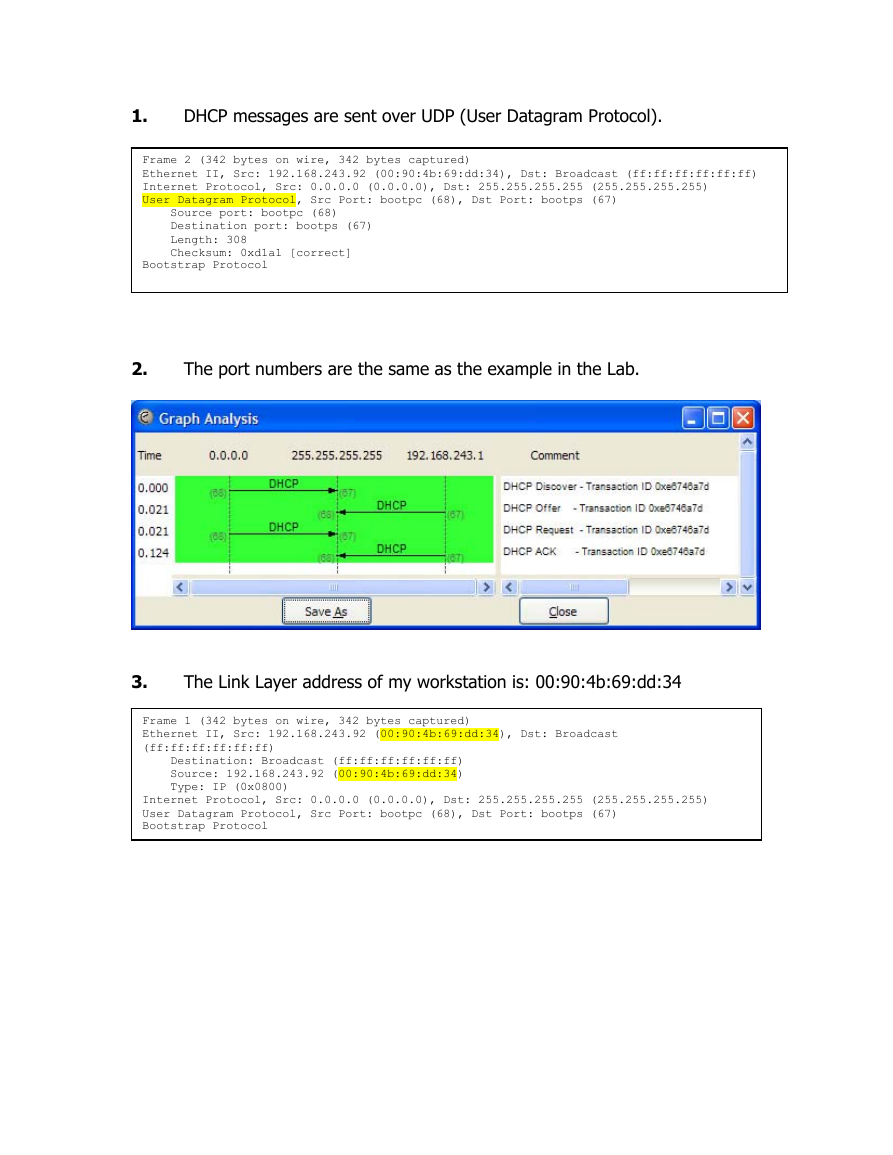
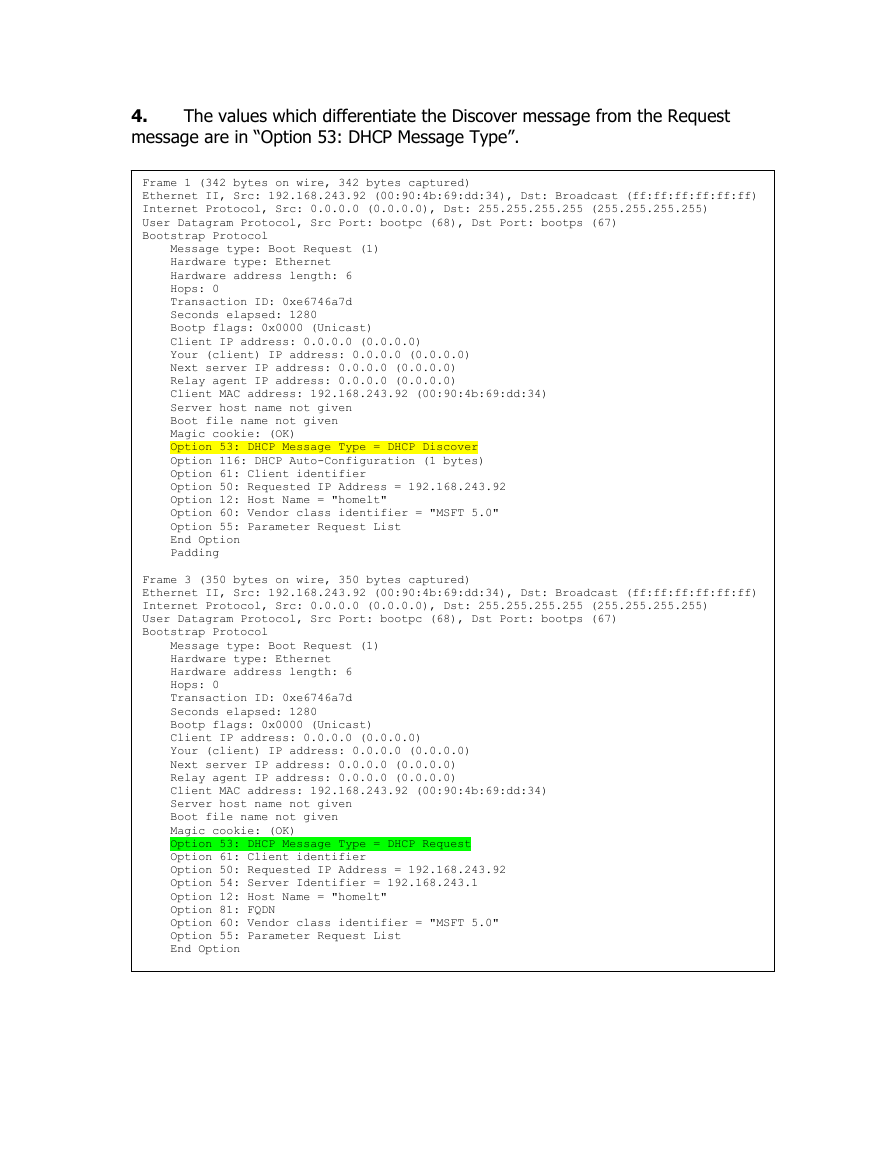

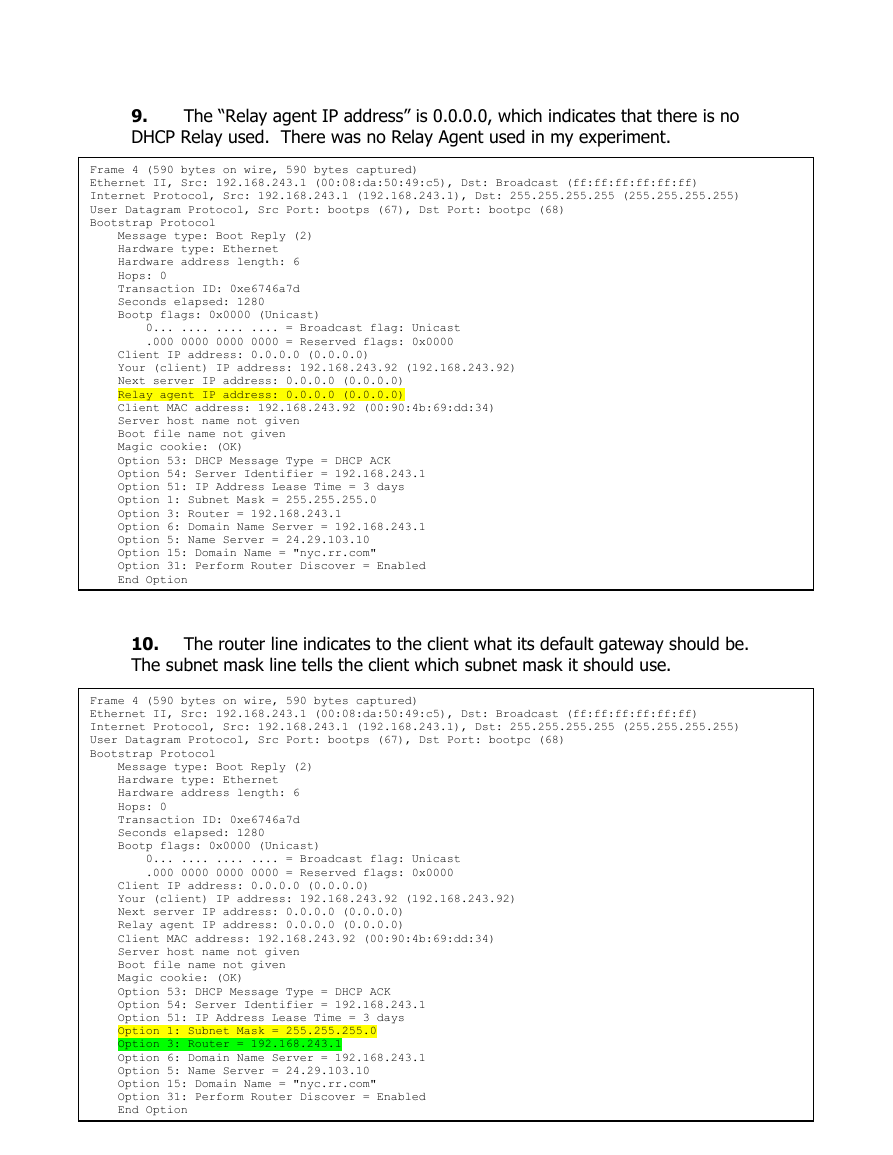
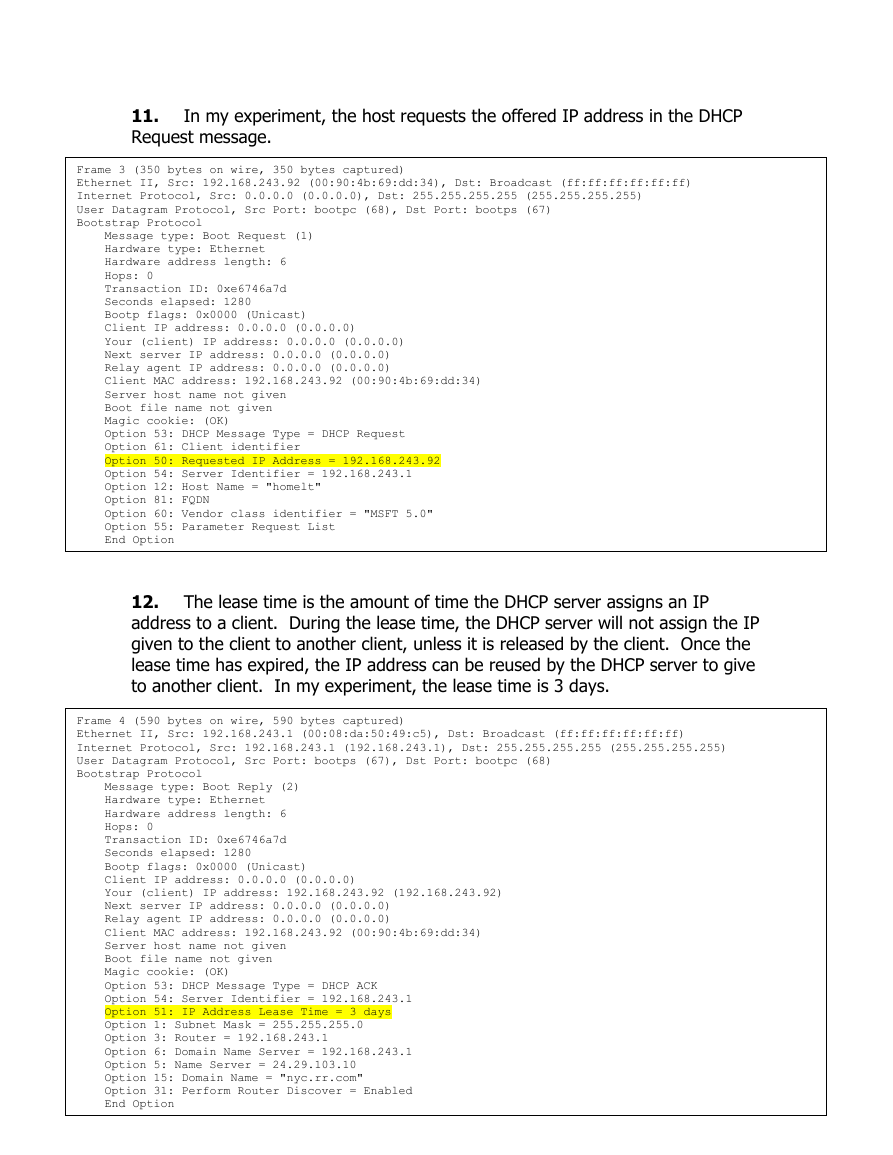
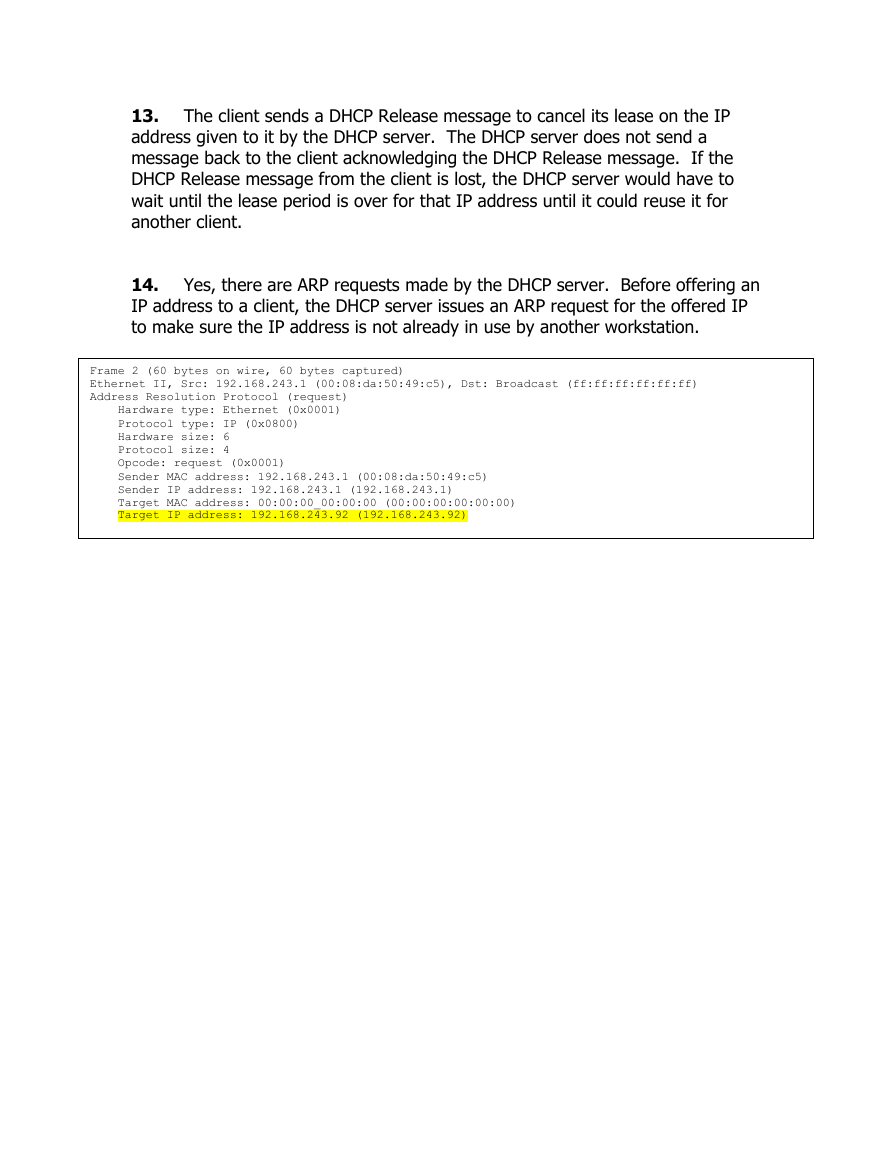







 2023年江西萍乡中考道德与法治真题及答案.doc
2023年江西萍乡中考道德与法治真题及答案.doc 2012年重庆南川中考生物真题及答案.doc
2012年重庆南川中考生物真题及答案.doc 2013年江西师范大学地理学综合及文艺理论基础考研真题.doc
2013年江西师范大学地理学综合及文艺理论基础考研真题.doc 2020年四川甘孜小升初语文真题及答案I卷.doc
2020年四川甘孜小升初语文真题及答案I卷.doc 2020年注册岩土工程师专业基础考试真题及答案.doc
2020年注册岩土工程师专业基础考试真题及答案.doc 2023-2024学年福建省厦门市九年级上学期数学月考试题及答案.doc
2023-2024学年福建省厦门市九年级上学期数学月考试题及答案.doc 2021-2022学年辽宁省沈阳市大东区九年级上学期语文期末试题及答案.doc
2021-2022学年辽宁省沈阳市大东区九年级上学期语文期末试题及答案.doc 2022-2023学年北京东城区初三第一学期物理期末试卷及答案.doc
2022-2023学年北京东城区初三第一学期物理期末试卷及答案.doc 2018上半年江西教师资格初中地理学科知识与教学能力真题及答案.doc
2018上半年江西教师资格初中地理学科知识与教学能力真题及答案.doc 2012年河北国家公务员申论考试真题及答案-省级.doc
2012年河北国家公务员申论考试真题及答案-省级.doc 2020-2021学年江苏省扬州市江都区邵樊片九年级上学期数学第一次质量检测试题及答案.doc
2020-2021学年江苏省扬州市江都区邵樊片九年级上学期数学第一次质量检测试题及答案.doc 2022下半年黑龙江教师资格证中学综合素质真题及答案.doc
2022下半年黑龙江教师资格证中学综合素质真题及答案.doc